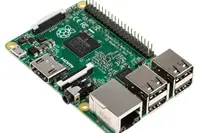Electronics News
Archive : 2 February 2015 год
 Raspberry Pi 2 - the next generation of the hugely popular single board computer – has been launched by its distributors and features upgraded capabilities, faster processor cores and a doubling in memory capacity to 1GB.
Raspberry Pi 2 - the next generation of the hugely popular single board computer – has been launched by its distributors and features upgraded capabilities, faster processor cores and a doubling in memory capacity to 1GB.
Raspberry Pi 2 incorporates the Broadcom BCM2836 application processor, containing a powerful ARM Cortex-A7 quad-core CPU running at 800MHz. This new processor makes the Raspberry Pi 2 more than six times more powerful than the first generation Raspberry Pi Model B+. The board layout, multimedia subsystem and peripherals remain fully compatible with the Raspberry Pi Model B+, including the use of the extensive 40-pin GPIO (General Purpose Input Output) connector, four USB ports and an efficient switching power supply.
The increased computing power and memory capacity of the Raspberry Pi 2 will bring benefits to hobbyists, hackers and home developers enabling them to develop more powerful applications that will run faster. In addition, OEMs will also be able to benefit from the new board's greater processing capacity as well as the Raspberry Pi platform's record of reliability and robustness. Those involved in educating the next generation of young programmers will also take notice of this highly capable new board.
Author
Tim Fryer
Source: www.newelectronics.co.uk
 Research published in Nature Materials by the University of Manchester and University of Sheffield shows that new 2D 'designer materials' can be produced to create flexible, see-through and more efficient electronic devices.
Research published in Nature Materials by the University of Manchester and University of Sheffield shows that new 2D 'designer materials' can be produced to create flexible, see-through and more efficient electronic devices.
Research published in Nature Materials by the University of Manchester and University of Sheffield shows that new 2D 'designer materials' can be produced to create flexible, see-through and more efficient electronic devices.
The team, led by Nobel Laureate Sir Kostya Novoselov, created LEDs which were engineered on an atomic level. The work is said to show that graphene and related 2D materials could be used to create thin, flexible, and even semi transparent light emitting devices for the next generation of consumer electronics products.
The LED, constructed by combining different 2D crystals, emits light from across its whole surface. Because they are less than 40 atoms thick, these new components can form the basis for the first generation of semi-transparent smart devices. By building stacked layers of various 2D materials to create bespoke functionality and introducing quantum wells to control the movement of electrons, new possibilities for graphene based optoelectronics are said to have been realised.
Freddie Withers, Royal Academy of Engineering Research Fellow at The University of Manchester, who led the production of the devices, said: "As our new type of LEDs only consist of a few atomic layers of 2D materials, they are flexible and transparent. We envisage a new generation of optoelectronic devices to stem from this work, from simple transparent lighting and lasers and to more complex applications."
Prof Alexander Tartakovskii, from the University of Sheffield, added: "Despite the early days in the raw materials manufacture, the quantum efficiency is already comparable to organic LEDs."
Author
Graham Pitcher
Source: www.newelectronics.co.uk
 In a move targets the connected home, Intel has signed a definitive agreement to acquire Lantiq, a leading supplier of broadband access and home networking technologies.
In a move targets the connected home, Intel has signed a definitive agreement to acquire Lantiq, a leading supplier of broadband access and home networking technologies.
"By 2018, we expect more than 800million broadband connected households worldwide," said Kirk Skaugen, general manager of Intel's Client Computing Group. "The combination of our cable gateway business with Lantiq's technology and talent can allow global service providers to introduce new home computing experiences and enable consumers to take advantage of a more smart and connected home."
Together, the companies will offer a wide range of connectivity solutions and home cloud technologies for OEMs, service providers and companies innovating new applications for the home.
"Intel and Lantiq share a common vision about the evolution of the connected home and the intelligent network," said Dan Artusi, pictured, Lantiq's CEO. "Together, we can drive the transformation of the broadband customer premises equipment as it becomes a smart gateway that connects an increasingly diverse roster of devices and services in the home."
Lantiq has more than 2000 patents related to broadband communications and offers technologies including; xDSL solutions, with vectoring and G.Fast; fibre based technologies, such as Fibre to the Distribution Point and GPON; gateway home networking and DSLTE systems; network processors; and Ethernet and voice solutions.
Author
Graham Pitcher
Source: www.newelectronics.co.uk
 STM32F042 и STM32F072 – новые представители семейства бюджетных микроконтроллеров STM32F0 на 32-битном ядре Cortex-M0 от ST Microelectronics. В новинках появилась периферия USB, CAN, HDMI, а также стало больше стандартной периферии – USART, SPI, I²C и таймеров.
STM32F042 и STM32F072 – новые представители семейства бюджетных микроконтроллеров STM32F0 на 32-битном ядре Cortex-M0 от ST Microelectronics. В новинках появилась периферия USB, CAN, HDMI, а также стало больше стандартной периферии – USART, SPI, I²C и таймеров.
Imec, Medtronic, Ghent University and their project partners are to work under the banner of the CARDIS project to develop and validate an early stage cardiovascular disease detection platform using integrated silicon photonics.
The project – supported by the EU's Horizon 2020 Framework Programme – aims to investigate and demonstrate a mobile, low cost device for the screening of arterial stiffness, detection of stenosis and heart failure in a clinical setting. To date, say the partners, there are no tools available to screen a large population set at primary care level on these parameters, and individuals that are considered to be at low or moderate risk too often go undiagnosed.
CARDIS research activities will include:
- The investigation, design and fabrication op the optical subsystems and components.
- The integration of the subsystems and building of a multi-array laser interferometer system.
- The development of a process flow scalable to high volumes for all subsystems and their integration steps.
- The investigation and development of the biomechanical model for translating optical signals related to skin-level vibrations into underlying CVD physiological events.
- The validation of the system in a clinical setting.
CARDIS, which will be managed by imec, is scheduled to run for 3½ years. Work will be undertaken at imec's associated laboratory at Ghent University, while the Medtronic Bakken Research Center in the Netherlands will be the scientific and technical coordinator. Other partners will include SIOS Messtechnik, University College Cork Tyndall, INSERM, Queen Mary University, Universiteit Maastricht, Ghent University and Fundico.
Author
Graham Pitcher
Source: www.newelectronics.co.uk

